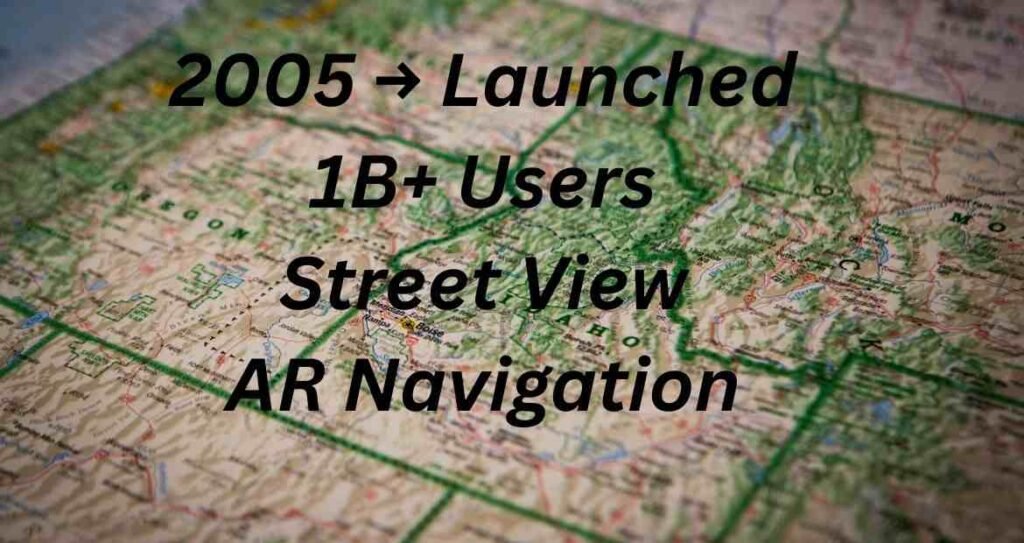Google Maps has become an essential tool for people worldwide, guiding millions every day through cities, roads, and even remote areas. From navigation to business discovery, this digital map service has reshaped how humans connect with their environment. Whether you are finding the fastest route, checking live traffic, or exploring new destinations, Google Maps is often the first choice. Its widespread adoption makes it one of the most powerful products in the digital era.
The History of Google Maps
The journey of Google Maps began in 2005 when Google introduced it as a web-based mapping solution. Initially, it started as a simple platform for locating places and directions. The idea was inspired by two Danish brothers, Lars and Jens Rasmussen, who developed mapping software that was later acquired by Google.
Over the years, Google Maps transformed from a static navigation service to a dynamic, real-time tool. In 2007, Google introduced Street View, giving users the ability to virtually walk down streets across the globe. This innovation not only improved navigation but also opened doors for businesses and tourism.
By the 2010s, the mobile version of Google Maps became a standard feature on smartphones. Integration with GPS technology made navigation more precise and user-friendly. Its continuous upgrades in 3D imagery, satellite views, and business listings further established it as the most reliable mapping service.
Features of Google Maps
Google Maps is not just about directions. It offers an ecosystem of features that benefit both individuals and businesses.
Navigation and Routes
Users can find driving, walking, biking, or public transit routes with real-time traffic updates. Google Maps uses artificial intelligence and crowd-sourced data to suggest faster alternatives.
Street View
The immersive Street View feature allows users to explore cities virtually. It gives a ground-level view of streets, landmarks, and even interiors of selected locations.
Local Business Listings
Businesses can create profiles that appear on Google Maps, increasing their visibility. Customers can view reviews, ratings, and essential details like opening hours.
Offline Maps
Travelers in remote areas benefit from offline maps. Users can download regions and use them without an internet connection.
Live Traffic and Transit Information
Google Maps provides live traffic updates, bus arrival times, and estimated delays, making commuting more predictable.
Importance of Google Maps in Daily Life
Google Maps has become an integral part of daily routines worldwide. For individuals, it saves time, reduces travel stress, and simplifies exploring unknown places. For businesses, it acts as a marketing channel by attracting customers through visibility in searches.
Tourism and travel industries have heavily benefited. Travelers can plan trips with ease, finding accommodations, restaurants, and attractions nearby. The integration with ride-hailing services like Uber further increased its practicality.
Educational institutions, emergency services, and logistics companies also rely on Google Maps for operational efficiency. It has moved far beyond being a simple app—it is now a necessity.
Statistics Highlighting Google Maps’ Growth
As of 2025, Google Maps has more than one billion monthly active users worldwide.
Around 67% of smartphone users rely on Google Maps regularly.
Businesses with verified Google Maps listings are 70% more likely to attract customers.
Google Maps cover more than 220 countries and territories.
Google Street View contains imagery from over 16 million kilometers of roads globally.
These statistics highlight how indispensable Google Maps has become, not only for individuals but also for global industries.

The Role of Google Maps in Business and Economy
Google Maps plays a significant role in driving local economies. Small and large businesses benefit from higher visibility when customers search for services nearby. Reviews and ratings influence buying decisions, which creates transparency and trust.
Delivery companies depend on Google Maps for optimized routes to reduce fuel costs and improve service times. Ride-sharing businesses also rely heavily on their data for navigation. This has transformed how local economies operate and grow in the digital era.
The Future of Google Maps
The future of Google Maps is rooted in artificial intelligence, augmented reality, and advanced data analytics. Features like Live View, which uses augmented reality to display navigation directions on real-world streets, are just the beginning.
In the coming years, users can expect:
More accurate indoor mapping for malls, airports, and hospitals.
Integration with autonomous vehicles for safer navigation.
Sustainable travel features help users choose eco-friendly routes.
AI-powered recommendations are making suggestions more personalized.
Google Maps is evolving from a simple guide to an intelligent assistant that anticipates user needs. Its future lies in blending the physical and digital world seamlessly.
Frequently Asked Questions (FAQs)
What is Google Maps used for?
Google Maps is used for navigation, business discovery, trip planning, and exploring geographic locations worldwide.
Can Google Maps work offline?
Yes. Users can download offline maps and use them without internet connectivity.
How accurate is Google Maps?
Google Maps is highly accurate but may vary depending on the location and available satellite data. Urban areas tend to have more precise information than rural regions.
Does Google Maps provide real-time traffic updates?
Yes. It uses GPS signals and data from other users to display live traffic conditions and suggest faster routes.
Is Google Maps free to use?
Yes. It is free for individual users, but businesses may pay for advertising and advanced services.
Conclusion
Google Maps has transformed the way people interact with the world. From its humble beginnings in 2005 to its role as a global navigation leader, it continues to shape daily life, business operations, and travel experiences. Its combination of features—navigation, local listings, Street View, and live traffic—make it indispensable. With advancements in artificial intelligence and augmented reality, Google Maps will only grow more powerful in the future.

